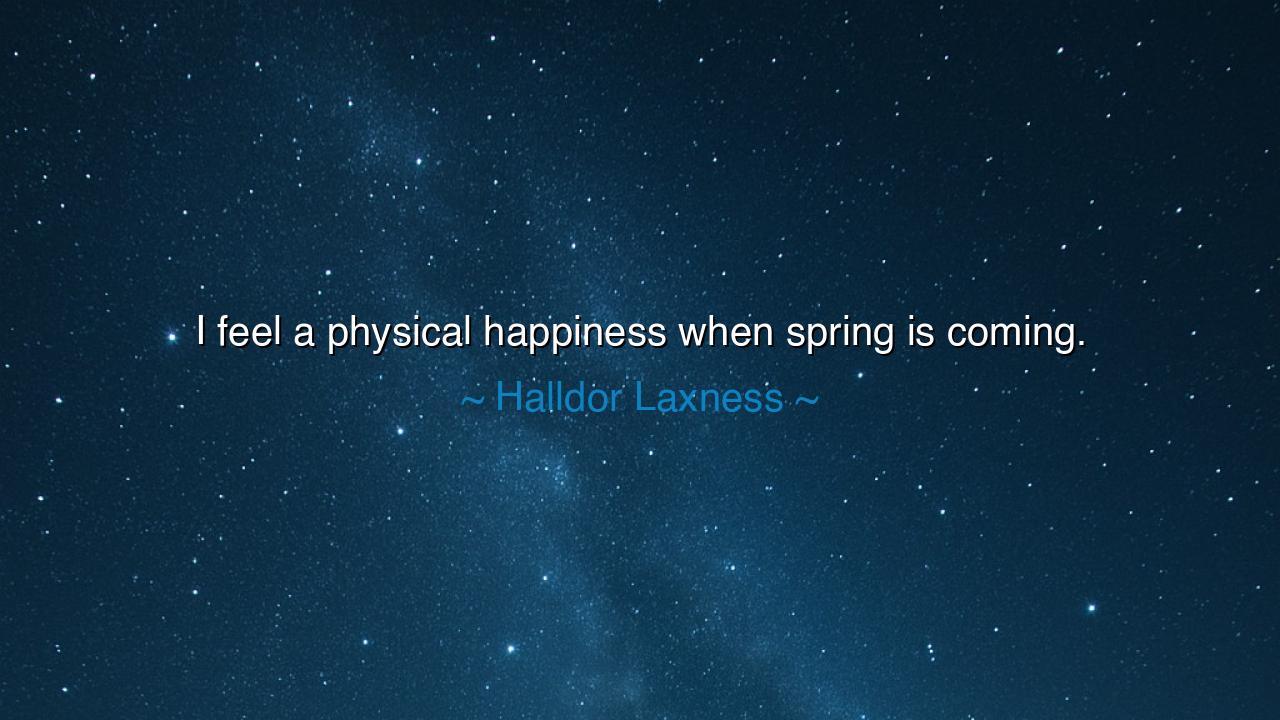
I feel a physical happiness when spring is coming.






“I feel a physical happiness when spring is coming.” — Thus spoke Halldór Laxness, the Icelandic sage and laureate, whose words carry the fragrance of thawing earth and the soft hum of returning life. In this brief confession, he reveals not merely a season’s joy, but the ancient bond between humanity and nature, between the beating of the heart and the turning of the world. To feel happiness not as thought, but as something physical, is to live in harmony with existence itself — to sense that one’s blood and breath are part of the great rhythm of creation.
In the northern lands from which Laxness came, winter is not a passing chill but a kingdom of endurance. The sun itself withdraws, leaving men and women to dwell beneath skies of stone and silence. It is a season of introspection, where the soul turns inward, and the fire within becomes the only warmth. Thus, when spring comes to Iceland — when the snow loosens its grip and the first green shoots rise timidly through the frozen soil — it is not a mere change of weather. It is a resurrection. The people feel it not in their minds, but in their very bones. The world awakens, and the body rejoices as if a divine hand has lifted its weariness.
Laxness, who chronicled the life of his rugged homeland with both tenderness and truth, understood this miracle well. His words are not the musings of comfort, but the song of one who has endured darkness and now stands in light. The physical happiness he speaks of is the joy that comes when the world’s renewal mirrors the renewal within the soul. It is the same happiness that ancient farmers must have felt when the first buds appeared, promising food and survival, or that poets of old felt when the frozen rivers began to sing again. Spring has always been the season of hope — the promise that no winter, no despair, no silence lasts forever.
The ancients honored this truth through festival and ritual. The Greeks celebrated Persephone’s return from the underworld, for in her ascent the earth was made fertile once more. The Romans crowned their altars with flowers to greet Flora, goddess of blossoms. And across the northern world, from the fjords of Scandinavia to the hills of Ireland, fires were kindled to drive away the last shadows of winter. These were not mere superstitions, but acts of gratitude — acknowledgments that the earth’s renewal was also the renewal of the human spirit. For when spring stirs the soil, it stirs also the heart.
We see echoes of this in every age. Think of the painter Claude Monet, who spent his life chasing the light of spring through his gardens at Giverny. Each brushstroke was a hymn to color’s return, to the breath of life after the gray of winter. Or think of the poet William Wordsworth, who, wandering lonely as a cloud, felt his spirit dance with daffodils. Both men, like Laxness, felt happiness not as luxury but as communion — a deep, bodily response to the living world’s beauty. Theirs was not an escape from reality, but a return to it — a reminder that to be alive is itself a kind of joy.
Yet in the modern age, many have forgotten this sacred rhythm. We live behind glass, beneath artificial light, our hearts insulated from the pulse of nature. We mark the seasons on calendars, but not in our blood. We chase happiness in possessions, when all along it lies waiting outside, in the whisper of wind through budding trees. Laxness’s words call us back — to walk, to breathe, to feel the world’s renewal in our bodies. For spring does not come only to the earth; it comes to every soul that allows itself to awaken.
The lesson is clear, simple, and profound: happiness is not only of the mind — it is of the body, the senses, the living bond with the earth. To feel joy as Laxness did, one must step out of the narrow chambers of thought and let the world touch you. Go outside when the snow melts; feel the sun on your face and the wind in your lungs. Plant something, even a single seed, and watch how life responds. In doing so, you will rediscover the truth that every winter ends, and that renewal is not only possible — it is promised.
So remember this, my child: when the first green breaks through the frost, do not hurry past it. Stop. Listen. Let it fill you. For that is the physical happiness of spring — not a fleeting delight, but the body’s ancient memory that life always returns. And when you feel it, you will know, as Laxness knew, that to live in harmony with the turning of the seasons is to walk the path of joy — the path that leads not away from the world, but deeper into its radiant heart.






AAdministratorAdministrator
Welcome, honored guests. Please leave a comment, we will respond soon